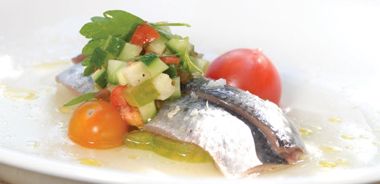Marinated Sardines with Cucumber and Heirloom Tomatoes

At the restaurant, Munn marinates his own sardines by combining 1/2 cup (125 mL) of white wine, 1 cup (250 mL) each of water and vinegar, and 1 Tbsp (15 mL) each of sugar and salt before bringing this mix to a boil, chilling it down, and pouring it over fresh sardines. Two days of pickling makes for perfection!
1/2 English cucumber, diced
1 to 2 large heirloom tomatoes (about 2 cups/500 mL), diced
2 Tbsp (30 mL) tarragon, coarsely chopped
1 cup (250 mL) whole Italian parsley leaves
6 Tbsp (90 mL) extra-virgin olive oil
2 Tbsp (30 mL) red wine vinegar
12 filets marinated sardines, store-bought or homemade
Salt and pepper to taste
Combine cucumber and tomato together with herbs, and toss lightly. Add olive oil and vinegar and season to taste. To assemble, place sardine filets in a shallow soup bowl or deep plate and place tomato-cucumber mix on top.
Divide any extra tomato juices amongst the bowls. (Chef’s tip: We sometimes garnish with a gazpacho consommé made by pureeing tomato, red onion, cucumber, garlic, vinegar, and salt, which is then strained through cheesecloth to get a clear juice or consommé.)
Serves 6.
source: "The Spirit of Café Brio", alive #308, June 2008




